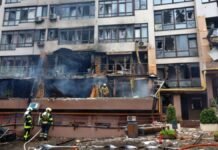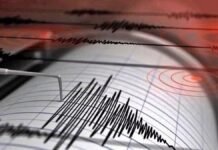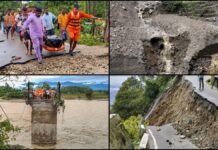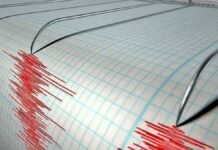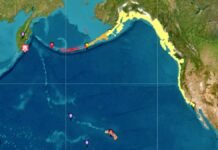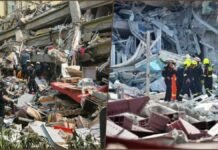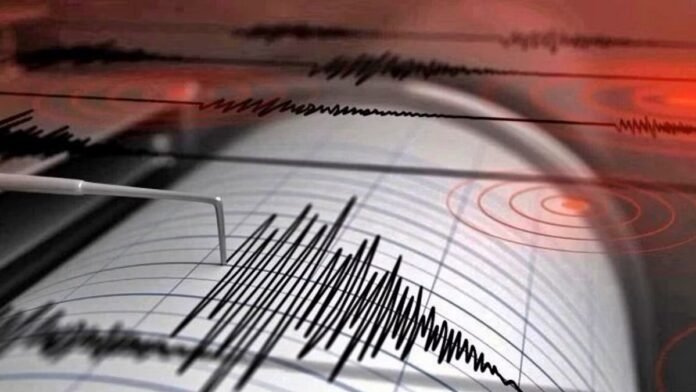
Key Points
- A devastating 7.6 magnitude earthquake struck Mindanao, Philippines at shallow depth of 10 km
- Phivolcs issued immediate tsunami warning for coastal areas with waves expected within 2 hours
- US Tsunami Warning System alerted regions within 300 km radius of epicenter
- Mass evacuations underway as residents flee to higher ground
- No major casualties reported initially, but aftershocks expected
- Region lies in highly active seismic zone where tectonic plates collide
- Relief operations launched focusing on hospitals, infrastructure, and damaged buildings
New Delhi: A catastrophic earthquake measuring 7.6 on the Richter scale has violently shaken the Mindanao region of the Philippines, triggering widespread panic and immediate tsunami warnings across coastal communities. The tremor, classified as extremely powerful, originated at a shallow depth of approximately 10 kilometers beneath the Earth’s surface, amplifying its destructive potential across the densely populated region.
Immediate Response and Evacuation
The Philippine Institute of Volcanology and Seismology (Phivolcs) swiftly issued tsunami warnings immediately following the seismic event. Authorities have ordered mandatory evacuations for all coastal residents, directing them to seek refuge on higher ground as a precautionary measure. The urgency of these directives stems from Phivolcs’ assessment that tsunami waves could strike shorelines within a two-hour window following the earthquake.
The US Tsunami Warning System has expanded the alert, warning that deadly tsunami waves could impact areas within a 300-kilometer radius of the epicenter. This expanded warning zone encompasses numerous coastal towns, cities, and island communities throughout the southern Philippines, placing millions of residents at potential risk.
Current Situation and Damage Assessment
According to preliminary reports from local authorities, no widespread destruction or major structural collapses have been confirmed in the immediate aftermath. However, the intensity of the earthquake was sufficiently severe to send terrified residents rushing from their homes into open spaces. The full extent of casualties, injuries, or fatalities remains unclear as official assessments are still underway in affected areas.
Emergency response teams have mobilized rapidly, with relief and rescue operations now active across the impact zone. Local government units are prioritizing critical infrastructure assessment, focusing particularly on hospitals, major roadways, and buildings showing signs of structural damage. Medical facilities are on high alert to receive potential casualties, while search and rescue teams stand ready to respond to any reports of trapped individuals.
Aftershock Warnings and Ongoing Threats
Seismological agencies have issued strong warnings about the likelihood of aftershocks, which could potentially cause additional damage to structures already weakened by the primary earthquake. Residents are being urged to remain vigilant and avoid returning to potentially unstable buildings. These secondary tremors, while typically less powerful than the main quake, pose serious risks in areas where structural integrity has been compromised.
The aftershock period could extend for days or even weeks, requiring sustained alertness from both authorities and residents. Emergency shelters are being established to accommodate those unable to safely return to their homes.
Seismic Vulnerability of the Philippines
The Philippines sits at one of the world’s most geologically volatile locations, where multiple tectonic plates converge and interact. The Philippine Sea Plate and the Eurasian Plate constantly collide and slide against each other in this region, creating enormous geological pressure. When this accumulated stress releases suddenly, it manifests as powerful earthquakes like the one experienced today.
The underwater location of many earthquake epicenters in this region creates the persistent threat of tsunamis. When seismic activity displaces large volumes of ocean water, massive waves form that can travel at high speeds toward coastal areas. These tsunami waves carry devastating force capable of overwhelming coastal defenses and causing catastrophic damage to communities.
Compounding Risk Factors
Several factors amplify the earthquake risk and potential damage in the Philippines. The nation’s high population density means that seismic events affect large numbers of people. Many buildings, particularly in rural and economically disadvantaged areas, are constructed using materials and methods that lack adequate seismic resistance. The concentration of major cities along coastlines places millions of residents directly in the path of both earthquake damage and tsunami threats.
Economic impacts from such disasters extend far beyond immediate destruction. Recovery and reconstruction efforts typically require years and substantial financial resources. The disruption to businesses, agriculture, tourism, and daily life creates rippling economic consequences that affect entire regions.
Importance of Disaster Preparedness
This earthquake serves as a critical reminder of the urgent need for comprehensive disaster management and earthquake preparedness systems throughout the Philippines. Investment in earthquake-resistant construction standards, early warning systems, public education programs, and robust emergency response capabilities remains essential for protecting lives and reducing economic losses.
Authorities continue monitoring the situation closely, with updated information being disseminated through official channels. Residents in affected areas are advised to follow all evacuation orders, stay away from coastal zones until the tsunami warning is lifted, and prepare for potential aftershocks by securing emergency supplies and identifying safe locations.






